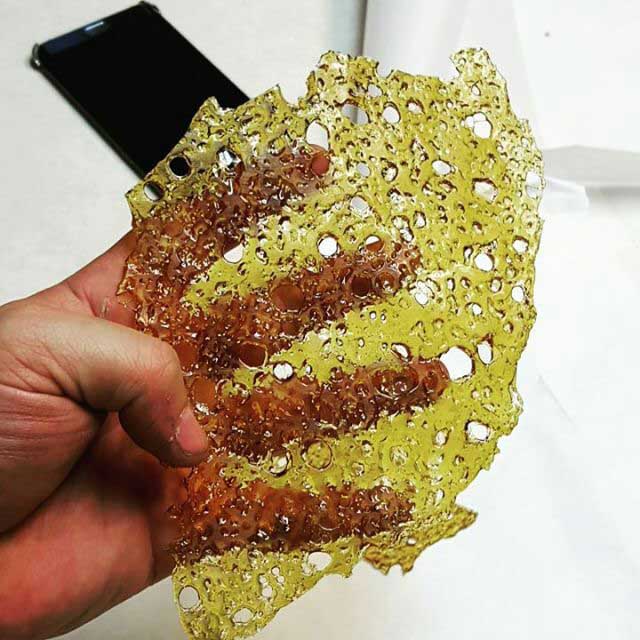The first drugs were likely discovered through accident and observation. As early humans tried different plant, animal, and mineral substances, they realized that some substances produced special medicinal effects. They were then able to use the substances that had beneficial effects to achieve desired results, and they passed their knowledge of these drugs from generation to generation.
This has not been the case with recreational drugs; with these, there has been a “fast track” to find new ways to create, distill and distribute highly addictive drugs for profit and gain. The latest addition to this race is the marijuana derivative called shatter.
Also called Butane Hash Oil (BHO), Shatter has several street names, including Honey Oil, Wax, Sap, and Budder. Shatter is still a relatively new marijuana concentrate that garnered its nicknames due to its brittle texture and color. Although some call it Dabs because the drug is used by taking a small amount of the extract and “dabbing” it onto a heated surface and then inhaling the smoke.
Even more alarming than Shatter’s highly addictive properties, however, is the manufacturing process, in which a natural plant is mixed with a chemical which, in turn, can often yield explosive results. At its base level, Shatter is concentrated marijuana that is extracted through an extremely volatile chemical process.
Shatter contains the same psychoactive properties as marijuana in the form of THC, but is much more potent than marijuana in its traditional form, containing upwards of 60-80% THC (held up against the usual 20% found in everyday marijuana). Men and women who use Shatter get higher faster, but the effects – which range from intoxicating to intense – often include bouts of overwhelming paranoia, anxiety, and even psychosis.
What Does Shatter Look Like?

To the untrained eye, Shatter may look like golden honey with a glass-like sheen to it. Upon closer inspection, however, one will notice that shatter is very brittle and fragile. It can easily break or shatter (hence its name) if dropped on a hard surface.
How Is Shatter Created?
To create Shatter, butane is used to extract cannabinoids and terpenes from cannabis plant matter yielding an extremely potent type of cannabis concentrate, known as Butane Hash Oil (hence the nickname BHO). These chemical compounds are secreted by cannabis plants and interact with receptors in the brain to relieve pain while causing a sense of euphoria and relaxation. This process is done using a solvent, typically butane or propane.
But careless home production efforts often lead to explosions, fires, and fatalities which negate any potential positive benefits that can come from having a more concentrated dose of THC.
Frankly put, when you weigh out the potential for loss of life, it is easy to see why to Shatter production is still mostly illegal even where medical marijuana is legalized. Add into the equation the fact that, with unregulated production, Shatter also often ends up containing harmful trace chemicals from the process. It becomes easy to see how one would wind up using a drug that is more toxic than its plant-based counterpart.
The notion that it’s just pot seems to be the rationale that has users smoking Shatter and then driving. Even though users notoriously pass out or slip into drug-induced psychosis shortly after partaking in the drug itself.
Shatter Drug Is Addictive
 Regardless of the hyperbole, marijuana can be addictive. When compounded by a personality with a propensity for addiction, it becomes doubly so. This is a problem because addicts will do whatever it takes to get high; even if that means endangering both their lives and the lives of those around them.
Regardless of the hyperbole, marijuana can be addictive. When compounded by a personality with a propensity for addiction, it becomes doubly so. This is a problem because addicts will do whatever it takes to get high; even if that means endangering both their lives and the lives of those around them.
As with any new drug on the scene, Shatter is quickly gaining popularity, especially in states where marijuana has been legalized. Young people, attracted to the color, psychotropic effects, and ritual of “shattering” the brittle product before smoking it have become fascinated with it. Bear in mind, that when BHO is purchased illegally, it typically comes from makeshift labs which usually results in shoddy production – meaning that the butane can almost always be found still in the mixture.
A small amount of this is placed on a heated surface that is connected (again, usually) to a water pipe. This process is called “dabbing” and can be extremely dangerous because of the fumes the addict is inhaling. This can result in side effects that include (but are not limited to) the following:
Side Effects of Shatter
- A weakening of the immune system
- Extreme irritation of the airways causing narrowing and spasms
- Infections such as bronchitis, asthma, and sinusitis
- Increased heart rate and blood pressure that can result in strokes
- Anxiety
- Loss of concentration and a weakened ability to remember things (“wet brain”)
- Physical dependence on cannabis concentrates that lead to tolerance (meaning larger and more frequent doses of Shatter will be needed to feel the same effects)
- Sleep disorders or problems sleeping
The thinking is that, because it is derived from marijuana, Shatter should be taken lightly, but this is not the case.
How Is Shatter Used?
Shatter is usually smoked through what is called a “dab rig” or a modified bong. A small piece of the shatter is placed on a metal nail which is then heated up using a blow torch. The heat from the nail causes the shatter to vaporize which is then inhaled through the dab rig. The entire process takes only seconds but can have profound effects that last for hours.
What Are The Effects Of Shatter?
The effects of shatter can be both mental and physical. Shatter is a very potent form of cannabis with a THC content that can range anywhere from 60-80%. This high concentration of THC can produce effects that are much more intense than what is experienced with other forms of cannabis such as flower or hash.
Shatter can cause an intense feeling of euphoria and relaxation. It can also cause users to experience changes in perception, mood, and cognition. Some people may also experience side effects such as paranoia, anxiety, or panic attacks.
What Is the Difference Between Shatter and Wax?
Shatter is a type of cannabis concentrate that gets its name from its shatter-like appearance. Unlike wax, shatter is made using a process of heating and cooling the cannabis extract to get rid of impurities, leaving behind a clear, glass-like product.
While shatter may look similar to wax at first glance, there are a few key differences between the two concentrates. For starters, shatter is typically much higher in THC than wax. Shatter drugs can have up to 90% THC content, making them one of the strongest cannabis concentrates on the market.
In addition to being more potent, shatter also tends to provide a more cerebral high that is perfect for treating conditions like anxiety and depression. Wax, on the other hand, is typically lower in THC and offers a more body-focused high that can be great for pain relief.
Shatter also tends to be more stable than wax, meaning it is less likely to degrade or lose potency over time. However, shatter is also more fragile and can shatter easily if dropped or mishandled.
What Are The Dangers Of Shatter?
Shatter is incredibly potent, often containing up to 90% THC. This high concentration can be extremely dangerous, especially for first-time users or those with little tolerance. The effects of shatter can be felt almost immediately and can last for several hours.
Shatter can also be quite dangerous to produce. Due to the use of flammable solvents like butane, there is a risk of explosion and fire during the extraction process.
Because shatter is so potent, it can be easy to overdo it and take too much. This can lead to an uncomfortable experience or even a bad trip.
Taking too much shatter can cause users to feel panicked, confused, and paranoid. They may also experience visual and auditory hallucinations. In extreme cases, people have reported feeling like they are going to die or that they are being chased by monsters.
Shatter is also dangerous because it can be laced with other drugs. For example, some dealers will mix shatter with methamphetamine to create a more potent product. This can be very dangerous and can lead to serious health problems or even death.
Westwind Recovery® Can Assist You With Shatter Addiction
If you or a loved one is using or experimenting with Shatter, more serious issues may be in play and you may require deeper investigation. In matters of possible drug addiction, it often behooves the reader to seek more information and, if necessary, professional guidance—such as from a luxury drug rehab California center that provides expert care and structured treatment.
There are several ways to end marijuana addiction here at Westwind Recovery®. We can help you get your feet back on the right track for long-term sobriety. Contact us today to learn more about how we can help you.

Dr. Deena is the Chief Clinical Officer of Westwind Recovery®, an award-winning outpatient treatment center in Los Angeles where she oversees the clinical and administrative program and treatment methods. Dr. Deena is a doctor of psychology and licensed clinical social worker since 1993. LCSW #20628. Originally from the East Coast, Dr. Deena has worked running treatment centers, worked as a therapist in psychiatric hospitals as well as school settings and currently has a thriving private practice in the LA area. Dr. Deena has appeared regularly on the Dr. Phil Show as an expert since 2003. She has also been featured on many other TV shows, podcasts and has contributed to written publications as well as podcasts.




